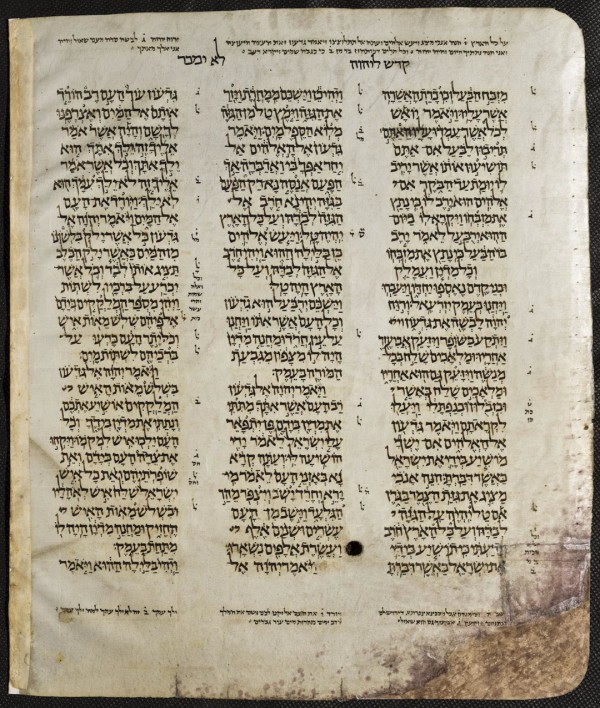“For everything that was written in the past was written to teach us, so that through the endurance taught in the Scriptures and the encouragement they provide we might have hope.” (Romans 15:4)
The United Nations Educational, Scientific and Cultural Organization (UNESCO) has added the oldest surviving manuscript of the Hebrew Bible, the Crown of Aleppo (Keter Aram Tzova), also known as the Aleppo Codex, to the Memory of the World Register, which is a compendium of the world’s documentary heritage.
The Codex, which is thought to be the first Hebrew Bible bound in handwritten book form, has navigated years of peril and intrigue since its beginnings in the Israeli city of Tiberias in the early tenth century.
It has been stolen by Crusaders, ransomed by the Jews of Cairo, smuggled away from its synagogue in Aleppo, Syria, and eventually, in 1958, carried back to Israel. It is currently protected at the Israel Museum’s Shrine of the Book where the Dead Sea Scrolls are also housed in climate controlled rooms.
“This is recognition of the Aleppo Codex as an integral part of humanity’s cultural treasures, and it’s miraculous that the manuscript, which was created in Israel, is part of the human legacy. The international recognition testifies to the status of the codex as part of the treasures of humanity and also to the enormous importance of the codex, which was written in Tiberias over 1,000 years ago,” said Dr, Adolfa Roitman, the curator of the Shrine of the Book. (Israel Hayom)

The Shrine of the Book is a wing of the Israel Museum in Jerusalem that houses the Dead Sea Scrolls and other rare, ancient manuscripts, including the Aleppo Codex. Two-thirds of the structure is below ground.
The fame of the Aleppo Codex rose long before UNESCO recognized it, and even before it arrived in Syria or made its way back to Jerusalem. It was consulted by generations of scribes searching for “authoritative answers to their textual queries” as well as “a model for the correct pointing, paragraphing, and formatting of the text.” (Israel Museum; Bible-Researcher)
The great Jewish authority Maimonides (1138–1204) even consulted it. He states:
“In these matters we relied upon the codex, now in Egypt, which contains the twenty-four books of Scripture and which had been in Jerusalem for several years. It was used as the standard text in the correction of books. Everyone relied on it, because it had been corrected by Ben Asher himself, who worked on its details closely for many years and corrected it many times whenever it was being copied. And I relied upon it in the Torah scroll that I wrote according to Jewish Law” (Sefer Ahavah, Hilkhot Sefer Torah 8:4).
Roitman said that all present versions of the Tanakh (the Old Testament) stem “in one way or another, from this ancient manuscript.” (i24news)

The second President of Israel Izhak Ben-Zvi with his wife Rachel Yanait Ben Zvi studying a copy of the Aleppo Codex.
For centuries, this manuscript remained hidden in a cave under the Central Synagogue of Aleppo in Syria. But when Israel was declared a nation in 1948, the Jewish community in Aleppo was attacked, and the world thought the codex was destroyed with other burned scrolls and manuscripts.
It miraculously survived and remained in the hands of local rabbis for ten years until it made its way back to the Holy Land, sadly missing most of the Torah as well as the books of Esther, Daniel, Ezra, Ecclesiastes, and Lamentations. In all, 294 of the original 487 pages have been recovered. (aleppocodex)
The ancient Central Synagogue of Aleppo, built in the 9th century AD, and its books are still in danger in Syria.
It faces the threat of complete destruction after already being damaged during fighting between Syrian President Bashar Assad, the Syrian rebels, and Islamic State forces.
“This synagogue is an important heritage site for the Jewish people, holding many historical and holy religious articles, which if destroyed, will take with them any memory of Jewish life from this ancient city,” said Israeli-American philanthropist Moti Kahana, founder of Amaliah (Arabic for “hope” and Hebrew for “work of God”), an organization dedicated to building up civil society and women’s rights in the Middle East. “We are doing everything in our power in order to save as many books and scrolls as possible.” (Arutz Sheva)
“We are working together with opposition forces in order to salvage the synagogue’s religious articles, an effort which has proven to be very costly and difficult,” Kahana said, reporting Amaliah has invested $2 million so far into its efforts to save the story of Jewish life in Aleppo, “which is part of the unique tapestry of the ancient Jewish life in the area.” (Jewish News)
Most of the Aleppo Bible, however, is now safe and is one of the foundational texts of our Messianic Prophecy Bible.








